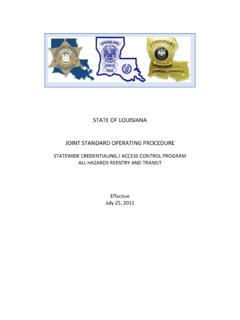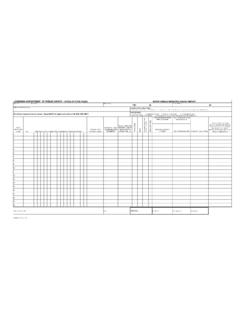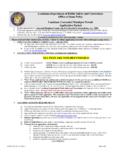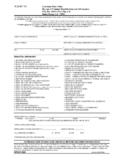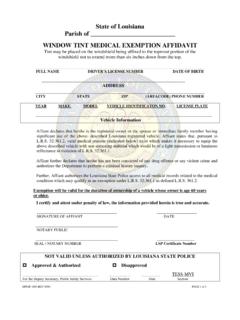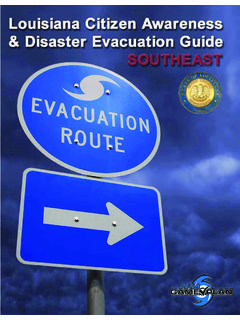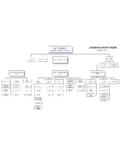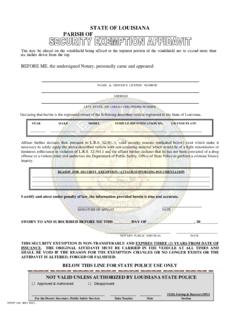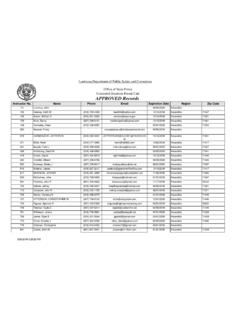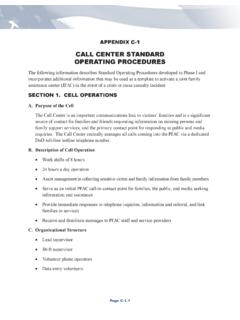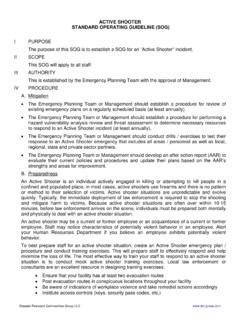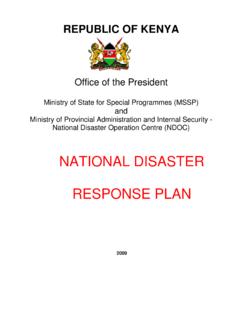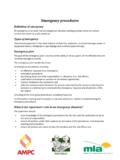Transcription of STATE OF LOUISIANA STANDARD OPERATING …
1 STATE OF LOUISIANA . STANDARD OPERATING PROCEDURE. statewide credentialing /Access Program All Hazards Access STATE OF LOUISIANA . STANDARD OPERATING PROCEDURE. Critical Infrastructure Owners/Operators Pilot Access Program All Hazards Access SUMMARY. Hurricane Katrina revealed a need for uniform reentry criteria for essential personnel entering a closed emergency area post disaster event. Lack of uniform access guidelines resulted in delays and loss of critical utilities and services, as well as delays in reestablishing security and communications systems following Katrina. This document outlines a model STANDARD OPERATING Procedure (SOP) for emergency response and management personnel at the STATE and local level in conjunction with critical infrastructure owners and operators (CI/OO) and their contractors, and other personnel.
2 This SOP seeks to clarify the roles, responsibilities, and processes that will be followed to ensure that critical infrastructure providers are given timely and efficient access to hurricane or other disaster- affected areas for the purpose of repairing the infrastructure. This document is a product of a joint Federal, STATE , Parish, local and private sector effort to ensure the timely functionality of critical infrastructure for citizens. This SOP was developed by the LOUISIANA STATE Police in partnership with the STATE of LOUISIANA Governor's Office of Homeland Security and Emergency Preparedness (GOHSEP), the National Department of Homeland Security, and the LOUISIANA Sheriffs and Chiefs of Police Associations.
3 Homeland Security Presidential Directive 12 (HSPD 12), dated August 27, 2004, entitled Policy for a Common Identification STANDARD for Federal Employees and Contractors, directed the promulgation of a Federal STANDARD for secure and reliable forms of identification for Federal employees and contractors. It further specified secure and reliable identification that, among other things: 1. Is strongly resistant to identity fraud, tampering, counterfeiting, and terrorist exploitation 2. Can be rapidly authenticated electronically 3. Is issued only by providers whose reliability has been established by an official accreditation process. The Federal STANDARD referenced above is the Federal Information Processing STANDARD 201(FIPS 201).
4 FIPS 201 technology uses a card with an Integrated Circuit Chip (ICC). (commonly called a smart card) which uses Public Key Infrastructure (PKI) for identity and attribute (qualification, certification, authorization, and/or privilege) authentication ensuring that the responder is who s/he says s/he is and that they truly possess the attribute(s) they say they do. Page 2 of 7. Although this is a Federal STANDARD , many STATE and local governments in the National Capital Region (NCR) and throughout the country are adopting this STANDARD to enable nation-wide interoperability. FIPS 201 STANDARD compliance will be an ongoing project with full implementation of standardized credentials by 2008 and will be incorporated in the next version of this SOP.
5 It is anticipated that reentry will occur in a tiered approach, based on key roles, in restoring normal operations after a disaster. Admittance will be granted based on the immediate needs and requirements of the locally affected area through the local EOC and Parish and STATE Governments. Tier 1 will include Search and Rescue Personnel, Infrastructure and Utilities Repair Personnel, Official Damage Assessment Teams, and other personnel at the discretion of the STATE , Parish, and local jurisdictions; Tier 2 will include Relief Workers ( Red Cross Volunteers), Healthcare Agencies (to include Volunteer Health Professionals (VHPs), Banking Organizations, Insurance Agencies, and Businesses deemed to be essential to the recovery effort.)
6 And Tier 3 will include Businesses not included in Tier 2 and residents. PROCESS OVERVIEW. All participants agree that the following criteria are essential elements for access into a restricted area during a hurricane or other natural disaster and will be administered ONLY in the event of a Declaration/ STATE of Emergency from the Governor or affected Parish President/Mayor when a mandatory evacuation order has been issued. It is imperative that local governments are familiar with utility and critical infrastructure needs and are aware of, based on the disaster, which critical infrastructure agencies (to include the LOUISIANA National Guard and the United States Coast Guard) will need immediate access to the affected area.
7 The following is a listing of identification that will be required to gain access at checkpoints: Critical Infrastructure Owners and Operators, to include Contractors, Subcontractors, and Personnel of the CI/OO, must have the following identification: 1. A valid STATE Drivers License and company-issued photo ID. 2. Marked Company vehicles (companies should have standardized markings). 3. Letter of Access (LOA) issued by the company (with verified phone number) stating that the bearer and vehicle is an authorized responder to the event. Federal Bureau of Investigation (FBI)-issued INFRAGARD credentials, the Department of Defense (DOD) Common Access Cards (CACs), and FIPS 201 compliant identification credentials issued by Federal government agencies will be acceptable forms of identification.
8 Page 3 of 7. SECTION I INTRODUCTION. PURPOSE. The purpose of this CI/OO Access SOP document is to describe in concept the joint Federal, STATE , Parish and local infrastructure strategy to permit access into restricted areas during the 2006 Hurricane Season. This SOP is intended for Federal, STATE , local representatives and private sector companies (critical infrastructure owners/operators) in LOUISIANA and to serve as an operational model for other States and municipalities. SECTION II CONCEPT OF OPERATIONS. A. REENTRY PROTOCOL. It is anticipated that reentry will occur in a tiered approach based on key roles in restoring normal operations after a disaster.
9 It is understood that events that may occur within specific jurisdictions will dictate, based on local needs and factors, what personnel will need access into the affected area. Safety, with regard to public health, travel accessibility and rescue operations will be paramount and of crucial importance in determining any access. (Immediate and unrestricted access) will be granted to Search and Rescue Agents, including agents from Parish and Municipal Fire-Rescue Departments, STATE , Local and Federal Law Enforcement, Fire/EMS, National Guard (Military), and Emergency Response Agencies in support of efforts in the affected area. Tier I. Infrastructure and Utilities Repair Personnel: These agencies must be permitted immediate access to ensure that essential services such as water, lighting, and communications are restored and infrastructure is intact.
10 Municipal utilities and public works personnel also are included. Official Damage Assessment Teams: These may include FEMA, STATE , and local officials. Other personnel at the discretion of the Parish Department of Homeland Security and Emergency Preparedness or applicable municipal Emergency Operations Center (EOC). Tier 2. Relief Workers: These groups will be needed to provide food and other supplies for people in impacted areas who did not evacuate. Healthcare Agencies: These include hospitals, nursing homes, assisted living facilities, and dialysis centers. Additionally, includes Volunteer Health Professionals (VHPs) with valid, approved identification documentation.
